Family
 Often when a robbery goes wrong, the would-be robbers decide that the best way out of the situation is to take hostages. The hope is to negotiate a way out of their pending imprisonment. Most hostage takings or sieges last a few hours but on September 28, 1975, The Spaghetti House siege began, and it continued until October 3, 1975. The Spaghetti House was a restaurant in Knightsbridge, London, and when the robbery went wrong, the police were on the scene so quickly that the robbers couldn’t get away. Seeing that they were trapped, the three robbers took the staff down into a storeroom and barricaded themselves in. The three robbers had been involved in black liberation organizations and tried to set the robbery as being politically motivated, thinking that a political standoff might have a better chance of success. The police did not believe them, however, and they stated that this was no more than a criminal act. Finally, they decided that the political ploy was not going to work, so the robbers released all the hostages unharmed after six days. I can’t say for sure that this was the longest robbery siege in history, but if it wasn’t, it ranked right up there. Finally, two of the gunmen gave themselves up, while the ringleader, Franklin Davies, shot himself in the stomach. He survived, and all three were later imprisoned, as were two accomplices. To keep tabs on the situation during the siege, the police used fiber optic camera technology, giving them live surveillance. They monitored the actions and conversations of the gunmen from the audio and visual output. They brought in a forensic psychiatrist to watch the feed and advise the police on the state of the men’s minds, and how to best manage the ongoing negotiations.
Often when a robbery goes wrong, the would-be robbers decide that the best way out of the situation is to take hostages. The hope is to negotiate a way out of their pending imprisonment. Most hostage takings or sieges last a few hours but on September 28, 1975, The Spaghetti House siege began, and it continued until October 3, 1975. The Spaghetti House was a restaurant in Knightsbridge, London, and when the robbery went wrong, the police were on the scene so quickly that the robbers couldn’t get away. Seeing that they were trapped, the three robbers took the staff down into a storeroom and barricaded themselves in. The three robbers had been involved in black liberation organizations and tried to set the robbery as being politically motivated, thinking that a political standoff might have a better chance of success. The police did not believe them, however, and they stated that this was no more than a criminal act. Finally, they decided that the political ploy was not going to work, so the robbers released all the hostages unharmed after six days. I can’t say for sure that this was the longest robbery siege in history, but if it wasn’t, it ranked right up there. Finally, two of the gunmen gave themselves up, while the ringleader, Franklin Davies, shot himself in the stomach. He survived, and all three were later imprisoned, as were two accomplices. To keep tabs on the situation during the siege, the police used fiber optic camera technology, giving them live surveillance. They monitored the actions and conversations of the gunmen from the audio and visual output. They brought in a forensic psychiatrist to watch the feed and advise the police on the state of the men’s minds, and how to best manage the ongoing negotiations.
There were a number of things that potentially led up to the robbery, not that these things were in any way a good excuse. Post-World War II Britain had a shortage of labor. Due to that shortage, the British decided to bring in workers from the British Empire and Commonwealth countries. These people came from poverty areas,  and while they were placed in low-pay, low-skill employment, which forced them to live in poor housing, it probably wasn’t much different than what they came from. Nevertheless, economic circumstances and what were seen by many in the black communities as racist policies applied by the British government, just like in other nations. This led to a rise in militancy, particularly among the West Indian community. The people grew angry, and their feelings were exacerbated by police harassment and discrimination in the education sector. The director of the Institute of Race Relations in the mid-1970s, Ambalavaner Sivanandan said that while the first generation had become partly assimilated into British society, the second generation were increasingly rebellious. These robbers were a part of that second generation.
and while they were placed in low-pay, low-skill employment, which forced them to live in poor housing, it probably wasn’t much different than what they came from. Nevertheless, economic circumstances and what were seen by many in the black communities as racist policies applied by the British government, just like in other nations. This led to a rise in militancy, particularly among the West Indian community. The people grew angry, and their feelings were exacerbated by police harassment and discrimination in the education sector. The director of the Institute of Race Relations in the mid-1970s, Ambalavaner Sivanandan said that while the first generation had become partly assimilated into British society, the second generation were increasingly rebellious. These robbers were a part of that second generation.
The ringleader, Franklin Davies was a 28-year-old Nigerian student who had previously served time in prison for armed robbery. The two men with him were Wesley Dick (later known as Shujaa Moshesh), who was a 24-year-old West Indian; and Anthony “Bonsu” Munroe, a 22-year-old Guyanese. The men were all involved in black liberation organizations at one time or another. Davies had tried to enlist in the guerrilla armies of Zimbabwe African National Union and FRELIMO in Africa. While Munroe had links to the Black Power movement. Dick was an attendee at meetings of the Black Panthers, the Black Liberation Front (BLF), the Fasimba, and the Black Unity and Freedom Party. He regularly visited the offices of the Institute of Race Relations to volunteer and access their library. Sivanandan and the historian Rob Waters identify that the three men were attempting to obtain money to “finance black supplementary schools and support African liberation struggles.”
By the mid-1970s the branch managers started a weekly tradition of closing the London-based Spaghetti House restaurant chain to meet at the company’s Knightsbridge branch. During that time, the outlet would be closed, but managers would deposit the week’s takings there, before it was paid into a night safe at a nearby bank. Of course, that was a well-known fact. So, at approximately 1:30am on Sunday, September 28, 1975, Davies, Moshesh, and Munroe entered the Knightsbridge branch of the Spaghetti House. One carried a sawed-off shotgun, and the others had handguns. The three men burst in and demanded the week’s takings from the chain, which was between £11,000 and £13,000. The restaurant was dimly lit, and it gave the staff a chance to 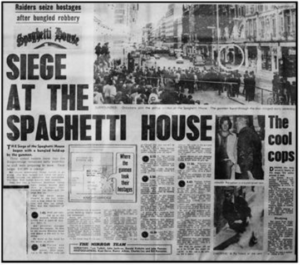 hide the briefcases of money under the tables. Now infuriated, the three men forced the staff down into the back, but the company’s general manager managed to escape out the rear fire escape.
hide the briefcases of money under the tables. Now infuriated, the three men forced the staff down into the back, but the company’s general manager managed to escape out the rear fire escape.
He quickly called the Metropolitan Police, who were at the scene within minutes. The getaway driver, Samuel Addison, realized that the plan was going wrong, so he decided that it was every man for himself, and drove off in a stolen Ford. The police entered the ground floor, so Davies and his colleagues forced the staff into a rear storeroom measuring 14 by 10 feet, locked the door, barricaded it with beer kegs. They began shouting at the police that they would shoot if they approached the door. The police surrounded the building, and the siege began. It would finally end on October 3, 1975, with the surrender of the robbers, and later the location and arrest of the two accomplices.
.

 My granddaughter-in-law, Athena Petersen has had a very busy year. Since her last birthday, she and my grandson, Josh Petersen had their first child, Justin Petersen, who was born on October 14, 2022. Then, they got married on June 24, 2023, and to finish the year in style, just nine days ago, they had their second child, Axel Petersen…for a set of Irish Twins. Irish Twins are siblings who were born within a twelve-month period. All this made for a very busy year, with all this taking place between two birthdays. Most of us would be hard pressed to get a third of this done in one year.
My granddaughter-in-law, Athena Petersen has had a very busy year. Since her last birthday, she and my grandson, Josh Petersen had their first child, Justin Petersen, who was born on October 14, 2022. Then, they got married on June 24, 2023, and to finish the year in style, just nine days ago, they had their second child, Axel Petersen…for a set of Irish Twins. Irish Twins are siblings who were born within a twelve-month period. All this made for a very busy year, with all this taking place between two birthdays. Most of us would be hard pressed to get a third of this done in one year.
Having Irish Twins is such a cool thing. I know, because I am also a mom of Irish Twins. As Athena and Josh with find out, the boys will have a period of time where they will be the same age. Sometimes they think that it’s cool, and sometimes not so much. It really depends on how old the kids 
 are. As they get older, it will become cool. They will also find out that they will have three years of diapers instead of four, although they will likely use the same number of diapers to do it. Having Irish Twins can be a lot of work…at first. Often the older child can’t walk when the younger one is born. My daughter didn’t walk until she was thirteen months old, so I had two month of carrying both kids. As for Athena and Josh, Justin is beginning to walk now, so that will be a little bit easier for them. Even with Justin walking, the first year with Irish Twins is a blessed, wild ride.
are. As they get older, it will become cool. They will also find out that they will have three years of diapers instead of four, although they will likely use the same number of diapers to do it. Having Irish Twins can be a lot of work…at first. Often the older child can’t walk when the younger one is born. My daughter didn’t walk until she was thirteen months old, so I had two month of carrying both kids. As for Athena and Josh, Justin is beginning to walk now, so that will be a little bit easier for them. Even with Justin walking, the first year with Irish Twins is a blessed, wild ride.

 Athena is a sweet girl and a wonderful mom, handling her older son with ease, as I know she will the two boys. She is a natural boy mom, having been auntie to a number of nephews, as some nieces too. Children love her, and she is a kid at heart, who can totally relate to children, making her a natural mom. She and Josh are so happy together, and we couldn’t have asked for a better wife for him. They are perfect for each other, and they have known each other for a long time. I think they will always be best friends, and that is the most important part of being husband and wife. If your husband is your best friend, your marriage will always be filled with comradery. That is my hope for Athena and Josh. It is God’s best for a marriage. Today is Athena’s birthday. Happy birthday Athena!! Have a great day!! We love you!!
Athena is a sweet girl and a wonderful mom, handling her older son with ease, as I know she will the two boys. She is a natural boy mom, having been auntie to a number of nephews, as some nieces too. Children love her, and she is a kid at heart, who can totally relate to children, making her a natural mom. She and Josh are so happy together, and we couldn’t have asked for a better wife for him. They are perfect for each other, and they have known each other for a long time. I think they will always be best friends, and that is the most important part of being husband and wife. If your husband is your best friend, your marriage will always be filled with comradery. That is my hope for Athena and Josh. It is God’s best for a marriage. Today is Athena’s birthday. Happy birthday Athena!! Have a great day!! We love you!!
 Imagine finding a ship, sitting fully intact on the bottom of a lake, as if the ship was built there. That is exactly what happened in 2019, when researchers from the marine sanctuary partnered with Ocean Exploration Trust, the group known for finding the Titanic in 1985, and embarked on a mapping expedition. The mission was sparked by the discovery of SS Ohio on the bottom of Lake Huron, in an area known as Shipwreck Alley. They knew that SS Ohio had gone down in the area following a collision with the schooner barge, Ironton, so it followed that if they had found SS Ohio, the Ironton must be nearby. Still, while they expected to find the wreck of the Ironton, what they actually found was…stunning!!
Imagine finding a ship, sitting fully intact on the bottom of a lake, as if the ship was built there. That is exactly what happened in 2019, when researchers from the marine sanctuary partnered with Ocean Exploration Trust, the group known for finding the Titanic in 1985, and embarked on a mapping expedition. The mission was sparked by the discovery of SS Ohio on the bottom of Lake Huron, in an area known as Shipwreck Alley. They knew that SS Ohio had gone down in the area following a collision with the schooner barge, Ironton, so it followed that if they had found SS Ohio, the Ironton must be nearby. Still, while they expected to find the wreck of the Ironton, what they actually found was…stunning!!
Ironton and SS Ohio, both sank in September 1894, following a collision that claimed the lives of five of the ship’s crew. The facts of the loss were only known because if the first-hand accounts of the wreck’s two survivors. Were it not for these survivors, the location might never have been known. Still, the wrecks sat on the lake floor for over a hundred years, waiting for a time in history when we had the technology and equipment necessary to actually go down and find the wrecks. What everyone who sailed the Great Lakes knows is that they are deep, and can be treacherous, especially in the winter…and “Shipwreck Alley” is an area of Lake Huron well known for its treacherous waters that have claimed the lives of many sailors.
On that fateful September day in 1894, the 190-foot steamer Charles J Kershaw departed Ashtabula, Ohio, on Lake Erie. She was towing the schooner barges Ironton and Moonlight. The vessels sailed empty, and they were destined for Marquette, Michigan, on Lake Superior. Things were going well, until at 12:30am on Sept. 26, while sailing north across Lake Huron under clear skies, Kershaw’s engine failed, leaving the ship without  power. This was the beginning of disaster. They might have been ok, had it not been for the notorious winds in “Shipwreck Alley.” The Kershaw was a few miles north of the Presque Isle Lighthouse, when a strong south wind pushed Moonlight and Ironton toward the disabled steamer. The crew attempted to avoid the impending entanglement and a possible collision. Moonlight’s crew cut Ironton’s tow line, detaching the steamer from the schooner barges. Still, the winds were not letting up, and now the ship and the barges were at their mercy.
power. This was the beginning of disaster. They might have been ok, had it not been for the notorious winds in “Shipwreck Alley.” The Kershaw was a few miles north of the Presque Isle Lighthouse, when a strong south wind pushed Moonlight and Ironton toward the disabled steamer. The crew attempted to avoid the impending entanglement and a possible collision. Moonlight’s crew cut Ironton’s tow line, detaching the steamer from the schooner barges. Still, the winds were not letting up, and now the ship and the barges were at their mercy.
When Ironton was cut loose, the crew suddenly found themselves adrift in the dark fighting the wind and praying that they didn’t hit anything. They fought with all that was in them to regain control of the ship. Under the direction of Captain Peter Girard, they fired up the vessel’s auxiliary steam engine to help set the struggling ship’s sails, but even with their best efforts, Ironton, being propelled by the wind from astern, veered off course into the path of the southbound steamer Ohio. The Ohio, a 203-foot wooden freighter was enroute to Ogdensburg, New York, from Duluth, Minnesota, loaded with 1,000 tons of grain.
The night was dark, so by the time Ironton’s crew spotted the approaching Ohio through the darkness, it was too late to avoid a head-on collision with the steamer. William Wooley of Cleveland, Ohio, a surviving crew member of Ironton, said, “At this time we sighted a steamer on our starboard bow. She came up across our bow and we struck her on the quarter about aft of the boiler house. A light was lowered over our bow, and we saw a hole in our port bow and our stem splintered.”
SS Ohio was found upright in 2017, over 122 years after her sinking in over 200 feet of water off Presque Isle,  Michigan. It was at this point that the search began for Ironton, which was expected to be nearby. In March, 2023, it was announced that Ironton had been located in 2019. The searchers waited to announce the finding, while they explored the vessel, hoping to discover how she could be in such pristine condition. The cold freshwater of the lake has kept the Ironton intact. According to Michigan Radio’s Jodi Westrick, an anchor is still connected to the ship, as are its three masts. In addition, a lifeboat remains tied to the vessel, a chilling reminder of how the ship’s demise played out on a harrowing night in 1894. It is as if time stood still for 1894 to the present day. Amazing!!
Michigan. It was at this point that the search began for Ironton, which was expected to be nearby. In March, 2023, it was announced that Ironton had been located in 2019. The searchers waited to announce the finding, while they explored the vessel, hoping to discover how she could be in such pristine condition. The cold freshwater of the lake has kept the Ironton intact. According to Michigan Radio’s Jodi Westrick, an anchor is still connected to the ship, as are its three masts. In addition, a lifeboat remains tied to the vessel, a chilling reminder of how the ship’s demise played out on a harrowing night in 1894. It is as if time stood still for 1894 to the present day. Amazing!!

 Life is changing drastically for my grandniece, Jolene Thompson. Recently, her family moved from Riverton, Wyoming to Shoshoni, Wyoming, and they now live on a farm. Jolene, who is very much an outdoor girl now gets to take care of animals, and that suits her just fine. With the move came a new school, and Jolene is really thriving there. Living in Shoshoni also puts her in the same town as her grandparents, and that closeness is going to be awesome. Jolene is such a social girl, so she has already made lots of friends already. Not everyone can just pick up and start over in a whole new place and immediately have a ton of friends, but Jolene can. Jolene has an amazing smile, and it draws people to her. She is truly a friend magnet. Not only does Jolene have lots of friends, but
Life is changing drastically for my grandniece, Jolene Thompson. Recently, her family moved from Riverton, Wyoming to Shoshoni, Wyoming, and they now live on a farm. Jolene, who is very much an outdoor girl now gets to take care of animals, and that suits her just fine. With the move came a new school, and Jolene is really thriving there. Living in Shoshoni also puts her in the same town as her grandparents, and that closeness is going to be awesome. Jolene is such a social girl, so she has already made lots of friends already. Not everyone can just pick up and start over in a whole new place and immediately have a ton of friends, but Jolene can. Jolene has an amazing smile, and it draws people to her. She is truly a friend magnet. Not only does Jolene have lots of friends, but 
 she is such a leader. When she makes friends, she is the leader of the pack too. She isn’t a girl who gets into trouble, so having her be the leader of the pack is definitely a great thing, and her friends’ parents love it.
she is such a leader. When she makes friends, she is the leader of the pack too. She isn’t a girl who gets into trouble, so having her be the leader of the pack is definitely a great thing, and her friends’ parents love it.
Jolene, who goes by Jo as much or more than Jolene, loves to fish. Her dad, Tim Thompson also loves to fish, hunt, go camping, and every other kind of outdoor activity, so it stands to reason that his daughter would also love these things. The family threw a great big birthday bash for Jo, and of course, the theme of the party was…you guessed it, fishing. Jo is her daddy’s mini-me, and if her daddy likes something, so does she. And to top it off, she is very good at all the outdoor sport things her daddy likes. She loves to catch bugs, hunt, fish, and really any of the outdoor things. And of course, 
 Jo can totally keep up with all the boys, but don’t let that fool you, because she is very much a girly girl…just not a wimpy girl. In fact, don’t call her a fisherman, because she is a fisher…GIRL!!
Jo can totally keep up with all the boys, but don’t let that fool you, because she is very much a girly girl…just not a wimpy girl. In fact, don’t call her a fisherman, because she is a fisher…GIRL!!
While Jo can and does “keep up with” the boys, she wants to dress and look like a girl! In fact, my niece, Kellie Hadlock (who is Tim’s girlfriend) says, “I dare you to try putting her in some Carhart overalls for fishing, lol!!” Outside of all that she is the toughest, sweetest, funniest, and smartest little girl!! Tim and Kellie are so incredibly proud of her!! Jo is very down to earth, but also very bubbly and fun, and our whole family feels blessed to know her. Today is Jo’s 8th birthday. Happy birthday Jo!! Have a great day!! We love you!!
 Our government is made up of three branches. The three branches of the United States government are the legislative, executive, and judicial branches. According to the doctrine of separation of powers, the United States Constitution distributed the power of the federal government among these three branches and built a system of checks and balances to ensure that no one branch could become too powerful. This is a long-standing system that has served the United States well, as long as it isn’t being abused.
Our government is made up of three branches. The three branches of the United States government are the legislative, executive, and judicial branches. According to the doctrine of separation of powers, the United States Constitution distributed the power of the federal government among these three branches and built a system of checks and balances to ensure that no one branch could become too powerful. This is a long-standing system that has served the United States well, as long as it isn’t being abused.
The judicial branch came into being when The Judiciary Act of 1789 was passed by Congress and signed by President George Washington, establishing the Supreme Court of the United States as a tribunal made up of six justices who were to serve on the court until death or retirement. Sometimes I’m not sure how I feel about the “until death or retirement” part, but I’m sure they had their reasons. To me, there are some justices, like some members of congress who far outstay their welcome. Nevertheless, on that day, President Washington nominated John Jay to preside as chief justice. He further named John Rutledge, William Cushing, John Blair, Robert Harrison, and James Wilson to be associate justices. On September 26, all six appointments were confirmed by the US Senate, and with that, we had our first Supreme Court. 
The US Supreme Court was established by Article 3 of the US Constitution. Article 3 granted the Supreme Court ultimate jurisdiction over all laws, especially those in which their constitutionality was at issue. In addition, the high court was also designated to oversee cases concerning treaties of the United States, foreign diplomats, admiralty practice, and maritime jurisdiction. The first session of the US Supreme Court was held on February 1, 1790, in New York City’s Royal Exchange Building.
The US Supreme Court quickly grew into the most important judicial body in the world in terms of its central place in the American political order. The Constitution allows Congress to set the size of the court…another part of the system that I don’t think I agree with, simply because a corrupt congress could take advantage of that ability by stacking the courts to rule in their favor. I’m sure that Washington and the founding fathers planned for the justices to be honest and trustworthy. I’m sure too, that the fact that they were Supreme Courts justices for life or until retirement, was planned to allow them to make their rulings without fear of being fired. Of course, there is more that one way to get a justice removed, because dead can come by more than one means, including murder. And justices could be threatened or have  their families threatened, causing them to vote in a specific way. In a perfect world, justices would act according to the Constitution, and vote their conscience, bringing about an honest and fair ruling, but that is not always the case…sadly. The number of justices varied during the 19th century before stabilizing in 1869 at nine. While this number can be changed at any time by Congress, so far, it has not, and I believe that the Constitution should be amended to make the number nine, permanent. In times of constitutional crisis, the Supreme Court has always played a definitive role in resolving, for better or worse, the great issues of the time, and the number nine has worked well. It should not be changed.
their families threatened, causing them to vote in a specific way. In a perfect world, justices would act according to the Constitution, and vote their conscience, bringing about an honest and fair ruling, but that is not always the case…sadly. The number of justices varied during the 19th century before stabilizing in 1869 at nine. While this number can be changed at any time by Congress, so far, it has not, and I believe that the Constitution should be amended to make the number nine, permanent. In times of constitutional crisis, the Supreme Court has always played a definitive role in resolving, for better or worse, the great issues of the time, and the number nine has worked well. It should not be changed.
 In 1945, a Japanese scientist named Shiro Ishii devised a plan of attack on civilians in the United States called Operation PX, also known as Operation Cherry Blossoms at Night. The plan was intended to wage biological warfare upon civilian population centers in the continental United States during the final months of World War II. The plan was devious, and heinous. Ishii planned to spread plague-infected fleas over Southern California using airplanes. The original operation was abandoned shortly after its planning on March 26, 1945. Then, with modifications, it was finalized and placed back of the table to be carried out. The plan was to be carried out on September 22nd, 1945. Unfortunately for Japan, their formal surrender date was August 15th, 1945, and the war was over.
In 1945, a Japanese scientist named Shiro Ishii devised a plan of attack on civilians in the United States called Operation PX, also known as Operation Cherry Blossoms at Night. The plan was intended to wage biological warfare upon civilian population centers in the continental United States during the final months of World War II. The plan was devious, and heinous. Ishii planned to spread plague-infected fleas over Southern California using airplanes. The original operation was abandoned shortly after its planning on March 26, 1945. Then, with modifications, it was finalized and placed back of the table to be carried out. The plan was to be carried out on September 22nd, 1945. Unfortunately for Japan, their formal surrender date was August 15th, 1945, and the war was over.
Originally, the Japanese Naval General Staff, led by Vice-Admiral Jisaburi Ozawa proposed Operation PX in December 1944. The code name for the operation came from the Japanese use of the code name PX for Pestis bacillus-infected fleas. The navy partnered with Lieutenant-General Shiro Ishii of Unit 731. Ishii possessed extensive experience on weaponizing pathogenic bacteria and human vulnerability to biological and chemical 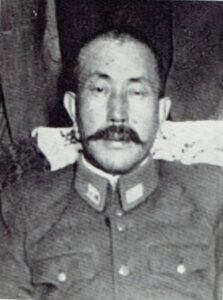 warfare, and he was an extremely evil man, willing to use his knowledge for the murders of millions of people, especially if he thought it would bring him more power.
warfare, and he was an extremely evil man, willing to use his knowledge for the murders of millions of people, especially if he thought it would bring him more power.
In Ishii’s plan, they would use Seiran aircraft launched by submarine aircraft carriers upon the West Coast of the United States, targeting specifically, the cities of San Diego, Los Angeles, and San Francisco. The attack was to be utilizing weaponized bubonic plague, cholera, typhus, dengue fever, and other pathogens in a biological terror attack upon the population of the United States. The original plan was to have the submarine crews infect themselves and run ashore in a suicide mission. When the operation was shelved in March of 1945, it was because Umezu could see the future ramifications, and conveyed as much, when he said, “If bacteriological warfare is conducted, it will grow from the dimension of war between Japan and America to an endless battle of humanity against bacteria. Japan will earn the derision of the world.”
The idea of suicide attacks was tabled, due to opposition from Yoshijiro Umezu and Torashiro Kawabe, who did not want Ishii to die in a suicide attack and asked him to instead “wait for [the] next opportunity calmly”. It was then that Ishii devised a final plan using of the biological weapons and fleas…an attack that never took place either. The world never knew of the planned attack until long after the war, when Operation PX was first 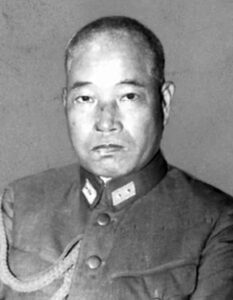
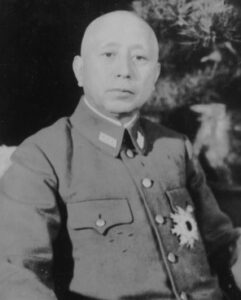 discussed in an interview by former captain Eno Yoshio, who was heavily involved with planning for the attack. He first spoke of it in an interview with Sankei on August 14, 1977. According to Yoshio, “This is the first time I have said anything about Operation PX, because it involved the rules of war and international law. The plan was not put into actual operation, but I felt that just the fact that it was formulated would cause international misunderstanding. I never even leaked anything to the staff of the war history archives at the Japanese Defense Agency, and I don’t feel comfortable talking about it even now. But at the time, Japan was losing badly, and any means to win would have been all right.” That interview goes to show how horrible some regimes can be.
discussed in an interview by former captain Eno Yoshio, who was heavily involved with planning for the attack. He first spoke of it in an interview with Sankei on August 14, 1977. According to Yoshio, “This is the first time I have said anything about Operation PX, because it involved the rules of war and international law. The plan was not put into actual operation, but I felt that just the fact that it was formulated would cause international misunderstanding. I never even leaked anything to the staff of the war history archives at the Japanese Defense Agency, and I don’t feel comfortable talking about it even now. But at the time, Japan was losing badly, and any means to win would have been all right.” That interview goes to show how horrible some regimes can be.

 My nephew, Jason Sawdon is a true caretaker. While many people have become caretakers by necessity, or because of their career choices, few are the kind of person that instinctively places the needs and comfort of others before their own needs. Jason is one of those few…true caretakers. Jason really loves making sure everyone around him is comfortable and that they have what they need. Jessi, my niece, Jason’s wife tells me that “It doesn’t matter if we have guests or if we’re camping, or if we are guests at someone’s house. He always makes sure everyone is situated first before taking care of himself.” That is the kind of thing that endears Jason to everyone who knows him.
My nephew, Jason Sawdon is a true caretaker. While many people have become caretakers by necessity, or because of their career choices, few are the kind of person that instinctively places the needs and comfort of others before their own needs. Jason is one of those few…true caretakers. Jason really loves making sure everyone around him is comfortable and that they have what they need. Jessi, my niece, Jason’s wife tells me that “It doesn’t matter if we have guests or if we’re camping, or if we are guests at someone’s house. He always makes sure everyone is situated first before taking care of himself.” That is the kind of thing that endears Jason to everyone who knows him.
Jason is the epitome of selflessness. Jason has such a caring nature, and on top of this, he is an incredibly 
 patient teacher. A couple of years ago, Jason was promoted to Sergeant of Equipment and Technology with the Wyoming Highway Patrol. Part of Jason’s job is to train people on the systems they use. There are a lot of people to train, and what they do is very important. When Jason is not working, he is always willing to lend a hand while teaching at the same time. Jason never acts frustrated if people ask questions…or how many times they ask. Jason never loses his patience with his students, and he is totally understanding when a student needs extra help. Jessi tells me, “I promise you’ve never met a more patient, understanding man.”
patient teacher. A couple of years ago, Jason was promoted to Sergeant of Equipment and Technology with the Wyoming Highway Patrol. Part of Jason’s job is to train people on the systems they use. There are a lot of people to train, and what they do is very important. When Jason is not working, he is always willing to lend a hand while teaching at the same time. Jason never acts frustrated if people ask questions…or how many times they ask. Jason never loses his patience with his students, and he is totally understanding when a student needs extra help. Jessi tells me, “I promise you’ve never met a more patient, understanding man.”
Jason love his family, and Jessi’s family. He is really good to all of them. He and Jessi have been spending a lot of time with Jessi’s sister, Lindsay Moore, her husband Shannon Moore, and daughter Mackenzie. They live about an hour away from each other, and that makes it convenient for both. And the little girls are very close, so they get cousin time, and we all know that’s important. Shannon is a coach for the Wyoming Cowboys, so 
 they go to a lot of the games, and everyone has a great time.
they go to a lot of the games, and everyone has a great time.
Jason is an incredible highway patrolman, but he is also a fun-loving guy, a great husband, and a wonderful dad to their daughter, Adelaide. Always making jokes and up for an adventure. Jessi and Adelaide love spending time with him. His job keeps him very busy, but he never lets anything come before his family. Of course, that means putting himself last again, because even when he is exhausted…family comes first. Jessi says, “Jason is just a generous all-around good guy that everyone loves and gravitates toward. We’re so blessed that he is ours and we get to celebrate him!” Today is Jason birthday. Happy birthday Jason!! Have a great day!! We love you!!
 Normally, in a monarchy, the successor is determined by bloodline. In a Republic, the successor is determined by an election. There are a number of people who seriously dislike monarchies, and then there are those who prefer it…they think it gives their nation stability and continuity. Be that as it may, when enough people decide to end a monarchy, they can get the job done. Such was the case in Revolutionary France, when the Legislative Assembly voted to abolish the monarchy and establish the First Republic.
Normally, in a monarchy, the successor is determined by bloodline. In a Republic, the successor is determined by an election. There are a number of people who seriously dislike monarchies, and then there are those who prefer it…they think it gives their nation stability and continuity. Be that as it may, when enough people decide to end a monarchy, they can get the job done. Such was the case in Revolutionary France, when the Legislative Assembly voted to abolish the monarchy and establish the First Republic.
Things had been going downhill for King Louis XVI and a year before the Legislative Assembly voted, he has no other choice but to approve a new constitution that stripped him of much of his power. This was the beginning of the end for King Louis XVI. Louis ascended to the French throne in 1774 as all monarchs do, by inheritance. From the  start, he was unsuited to deal with the severe financial problems that he inherited from his predecessors, along with the throne. Unfortunately, not all those who would inherit the throne of a nation are suited for that leadership.
start, he was unsuited to deal with the severe financial problems that he inherited from his predecessors, along with the throne. Unfortunately, not all those who would inherit the throne of a nation are suited for that leadership.
The situation continued to escalate, and in 1789, food shortages and economic crises led to the outbreak of the French Revolution. By August of 1792, things escalated to a boil. At that point, King Louis and his queen, Mary-Antoinette, were imprisoned and in September the monarchy was abolished. Soon after their imprisonment,  evidence of Louis’ counterrevolutionary activity with foreign nations was discovered. He was put on trial for treason. I don’t know the details of the case for treason, but of course, he could not have been put on trial before the changes that were forced upon him in the changing of the constitution. It is also possible that there were no legitimate charges to used, until they forced the changing of the constitution. I’m sure there are opinions on both sides of the issue.
evidence of Louis’ counterrevolutionary activity with foreign nations was discovered. He was put on trial for treason. I don’t know the details of the case for treason, but of course, he could not have been put on trial before the changes that were forced upon him in the changing of the constitution. It is also possible that there were no legitimate charges to used, until they forced the changing of the constitution. I’m sure there are opinions on both sides of the issue.
Louis was convicted and condemned to death by a narrow majority in January of 1793, and on January 21, 1793, he walked steadfastly to the guillotine and was executed. His head was held high, and he proclaimed his innocence to the very end. Nine months later, his queen, Marie-Antoinette followed him to the guillotine. Neither of them ever confessed to the crimes for which they were committed, and I don’t suppose we will ever know the truth about the matter.
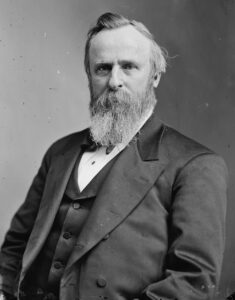 When we think of a president of the United States, we think of one each term. In reality, on inauguration years, there are actually two…the outgoing president, and the incoming president. Of course, if the president has won a second term, there would actually be only one in that inauguration cycle. That is the common fact of presidential inaugurations, but could there be three? The answer is actually, yes. There have been two times in history when there were three presidents in one year. I suppose that potentially there could be more than this, but the reasons would almost be too awful to contemplate.
When we think of a president of the United States, we think of one each term. In reality, on inauguration years, there are actually two…the outgoing president, and the incoming president. Of course, if the president has won a second term, there would actually be only one in that inauguration cycle. That is the common fact of presidential inaugurations, but could there be three? The answer is actually, yes. There have been two times in history when there were three presidents in one year. I suppose that potentially there could be more than this, but the reasons would almost be too awful to contemplate.
On September 20, 1881, Chester Arthur became one of those two “third” presidents, when he was inaugurated that day, becoming the third person to serve as president in that year. The year 1881 began with Republican Rutherford B Hayes in office. Hayes 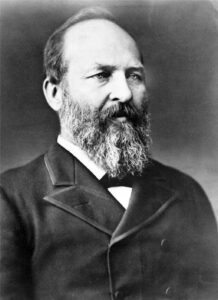 had just completed his first and only term as president, and with the inauguration of James A Garfield, Hayes had officially turned over the reins of government to the new president, who happened to be a close friend of his, in March 1881. Then, the unthinkable happened, when just four months into his term, on July 2, Garfield was shot by an assassin named Charles Guiteau. Guiteau said that he killed Garfield because he refused to grant Guiteau a political appointment. The attack left Garfield with wounds to his back and abdomen. He struggled to recover throughout the summer. Though it appeared he would pull through in early September, Garfield deteriorated by mid-September and finally died on September 19th. An autopsy report revealed that the internal bullet wound contributed to an aneurism that ultimately killed Garfield.
had just completed his first and only term as president, and with the inauguration of James A Garfield, Hayes had officially turned over the reins of government to the new president, who happened to be a close friend of his, in March 1881. Then, the unthinkable happened, when just four months into his term, on July 2, Garfield was shot by an assassin named Charles Guiteau. Guiteau said that he killed Garfield because he refused to grant Guiteau a political appointment. The attack left Garfield with wounds to his back and abdomen. He struggled to recover throughout the summer. Though it appeared he would pull through in early September, Garfield deteriorated by mid-September and finally died on September 19th. An autopsy report revealed that the internal bullet wound contributed to an aneurism that ultimately killed Garfield.
On September 20, 1881…the next day, Vice President Chester Arthur was sworn in as 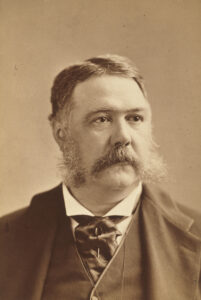 president, making him the third man to be sworn in as president in 1881. Garfield’s assassin then actually had the nerve to write to the new president from jail, and actually taking credit for vaulting Arthur into the White House. While President Arthur was president, not everyone felt like he was a good president. Former President Hayes, said of the Arthur administration, that it was best known for “liquor, snobbery and worse.” Of course, Hayes could have been angry about not being elected to a second term, or he could have been making an honest evaluation. that may be a good subject for a future story. Either way, Chester Arthur served only one term from 1881 to 1885.
president, making him the third man to be sworn in as president in 1881. Garfield’s assassin then actually had the nerve to write to the new president from jail, and actually taking credit for vaulting Arthur into the White House. While President Arthur was president, not everyone felt like he was a good president. Former President Hayes, said of the Arthur administration, that it was best known for “liquor, snobbery and worse.” Of course, Hayes could have been angry about not being elected to a second term, or he could have been making an honest evaluation. that may be a good subject for a future story. Either way, Chester Arthur served only one term from 1881 to 1885.
While this was a very unusual year, it was not the first time this had happened. It was actually the second time in American history that three men served as president in one year. A similar situation occurred in 1841, when Martin Van Buren, William Henry Harrison, and John Tyler all held the office, but that is a different story for another day.
 Many people have had to switch from their dominant hand due to an accident, stroke, or amputation, but we rarely think of a president find himself in that position. Nevertheless, Thomas Jefferson had to do just that. It can happen to anyone really, but like many a young man, Thomas Jefferson was out to impress a girl. The strange part was that when it happened, Thomas wasn’t a young man. He was, nevertheless, trying to impress a girl. Thomas was 42 years old. He wasn’t the president of the United States yet, but he had been married. He married Martha Wayles in 1772, but she passed away in 1782, so he was alone. He and Martha had six children. Of the six children born to Thomas and Martha, only two survived to adulthood, Martha and Mary. His wife, Martha died four months after the birth of her last child. He had been happy, but his marriage was short. Thomas Jefferson was not perfect, and in fact he made lots of mistakes, and even had children with his slave, but he was a good president…and which of us is perfect, after all.
Many people have had to switch from their dominant hand due to an accident, stroke, or amputation, but we rarely think of a president find himself in that position. Nevertheless, Thomas Jefferson had to do just that. It can happen to anyone really, but like many a young man, Thomas Jefferson was out to impress a girl. The strange part was that when it happened, Thomas wasn’t a young man. He was, nevertheless, trying to impress a girl. Thomas was 42 years old. He wasn’t the president of the United States yet, but he had been married. He married Martha Wayles in 1772, but she passed away in 1782, so he was alone. He and Martha had six children. Of the six children born to Thomas and Martha, only two survived to adulthood, Martha and Mary. His wife, Martha died four months after the birth of her last child. He had been happy, but his marriage was short. Thomas Jefferson was not perfect, and in fact he made lots of mistakes, and even had children with his slave, but he was a good president…and which of us is perfect, after all.
In 1785, Thomas was in Paris, and he met a woman named Maria Cosway, who was a married woman. Thomas Jefferson took a liking to her, and he was trying to impress her. Well, he shouldn’t have been doing what he did. He knew it, and we know it to this day, but he did try to impress her, by trying to jump over a fence. In the ensuing accident, whereby he fell, Thomas Jefferson broke his right wrist. The surgeon set his wrist, but he didn’t really do a good job of it. After they set his wrist bones, he suffered chronic pain in his left hand for the rest of his life. He was really unable to use his left hand much at all after that. 
The accident forced Thomas Jefferson to stay in his house for a month, during which time, his secretary, William Short, had to write his letters for him. For a few months, he used his left hand to write letters including the famous “Head and Heart” letter on October 12 to Maria Cosway. The broken wrist caused him to have to cut short the planned sightseeing trip with Maria Cosway, and it also cause him to have to postpone his journey to the south of France. In the end, his wrist finally healed, but it was never to the point that he could use it as his dominant hand, so he had to switch out his dominant hand and live the rest of his life as a lefty. I suppose some might have said that his infatuation with Maria Cosway cost him the use of his hand, in a sort of “repercussion for bad behavior” scenario, but I don’t believe in the “God will hit you with a lightning bolt” kind of punishment. I know that it likely wouldn’t have happened if he had left Maria Cosway alone, but I just think God tries for grace first.

